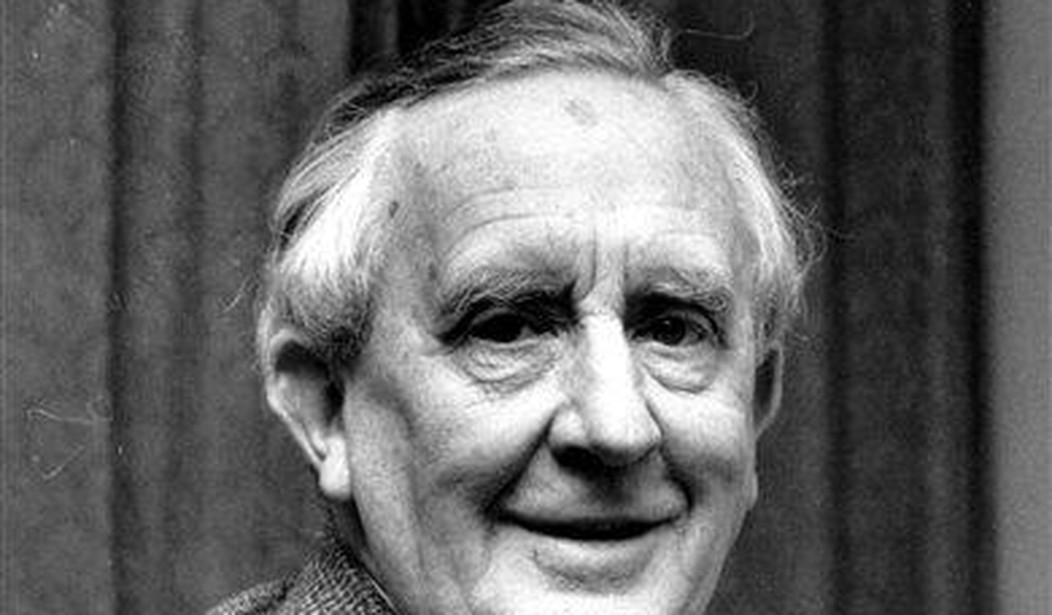The 2003 release of Peter Jackson’s film version of The Lord of the Rings coincided with America’s response to 9/11, the invasion of Iraq. Tolkien’s inspired story of the West’s defense against barbarism well suited a national mood of optimism and indignation. Sadly, the Amazon series “Rings of Power” that premiers Sept. 1 appears to reduce Tolkien’s earlier work to a high-budget version of “Game of Thrones,” if the publicity material is any guide. Sadly, that may fit today’s tenebrous national mood as aptly as Jackson’s trilogy reflected our high spirits of twenty years ago.
There is a reason that Amazon readers chose Tolkien as the greatest English-language novelist of the 20th century. As a purely literary production The Lord of the Rings is a mediocre work, but as the vehicle for a Christian vision of man in civilization it had no peers.
Tolkien’s early writings depicting the pre-history of the Lord of the Rings as tragedy, not epic. The pagan virtues of courage, self-sacrifice and forbearance celebrated by Homer are not self-sufficient in Tolkien’s account. In the absence of divine guidance they can only produce tragic consequences. Of Tolkien’s posthumous writings his story of the children of Hurin is unique as a standalone novel. It first appeared in 2007. Below is my review of this remarkable work. I repost it because due to the website overhauls it is no longer available on the site of Asia Times. I hope it will remind us of Tolkien’s higher purpose, and serve as an antidote to the trivialization of his work.
Tolkien’s Christianity and the Pagan Tragedy
by Spengler
The Children of Húrin, by J.R.R. Tolkien, edited by Christopher Tolkien (Houghton Mifflin: Boston 2007).
J. R. R. Tolkien was the most Christian of twentieth-century writers, not because he produced Christian allegory and apologetics like his friend C.S. Lewis, but because he uniquely portrayed the tragic nature of what Christianity replaced. Thanks to the diligence of his son Christopher, who reconstructed the present volume from several manuscripts, we have before us a treasure that sheds light on the greater purpose of his The Lord of the Rings.
In The Children of Húrin, a tragedy set some six thousand years before the tales recounted in The Lord of the Rings, we see clearly why it was that Tolkien sought to give the English-speaking peoples a new pre-Christian mythology. It is a commonplace of Tolkien scholarship that the writer, the leading Anglo-Saxon scholar of his generation, sought to restore to the English their lost mythology. In this respect the standard critical sources (for example Edmund Wainwright) mistake Tolkien’s profoundly Christian motive. In place of the heroes Siegfried and Beowulf, the exemplars of German and Anglo-Saxon pagan myth, we have the accursed warrior Túrin, whose pride of blood and loyalty to tribe leave him vulnerable to manipulation by the forces of evil.
Tolkien’s popular Ring trilogy, I have attempted to show, sought to undermine and supplant Richard Wagner’s operatic Ring cycle, which had offered so much inspiration for Nazism.[i] With the reconstruction of the young Tolkien’s pre-history of Middle-Earth, we discern a far broader purpose: to recast as tragedy the heroic myths of pre-Christian peoples, in which the tragic flaw is the pagan’s tribal identity. Tolkien saw his generation decimated, and his circle of friends exterminated, by the nationalist compulsions of the First World War; he saw the cult of Siegfried replace the cult of Christ during the Second. His life’s work was to attack the pagan flaw at the foundation of the West.
It is too simple to consider Tolkien’s protagonist Túrin as a conflation of Siegfried and Beowulf, but the defining moments in Túrin’s bitter life refer clearly to the older myths, with a crucial difference: the same qualities that make Siegfried and Beowulf exemplars to the pagans instead make Túrin a victim of dark forces, and a menace to all who love him. Tolkien was the anti-Wagner, and Túrin is the anti-Siegfried, the anti-Beowulf. Tolkien reconstructed a mythology for the English not (as Wainwright and other suggest) because he thought it might make them proud of themselves, but rather because he believed that the actual pagan mythology was not good enough to be a predecessor to Christianity.
“Alone among 20th century novelists, J R R Tolkien concerned himself with the mortality not of individuals but of peoples. The young soldier-scholar of World War I viewed the uncertain fate of European nations through the mirror of the Dark Ages, when the life of small peoples hung by a thread,” I wrote in an earlier essay.[ii] Christianity demands of the Gentile that he reject his sinful flesh and be reborn into Israel; only through a new birth can the Gentile escape both the death of his own body as well as the death of his hopes in the inevitable extinction of his people.
Tolkien is a writer of greater theological depth than his Oxford colleague C.S. Lewis, in my judgment. Lewis is a felicitous writer and a diligent apologist, but mere allegory along the lines of the Narnia series can do no more than re-state Christian doctrine; it cannot really expand our experience of it. Tolkien takes us to the dark frontier of a world that is not yet Christian, and there is tragic, but has the capacity to become Christian. It is the world of the Dark Ages, in which barbarians first encounter the light. It is not fantasy, but rather a distillation of the spiritual history of the West. Whereas C.S. Lewis tries to make us comfortable in what we already believe by dressing up the story as a children’s masquerade, Tolkien makes us profoundly uncomfortable. Our people, our culture, our language, our toehold upon this shifting and uncertain earth is no more secure than that of a thousand extinct tribes of the Dark Ages; and a greater hope than that of the work of our hands and the hone of our swords must avail us.
Tolkien set The Children of Húrin in a doomed world menaced by a fallen angel of sorts, the Lucifer-like Morgoth. An alliance of mortal men and immortal Elves attacks Morgoth’s stronghold but is crushed and dispersed; only a few hidden Elvish strongholds remain free. Húrin is the lord of a small land and a leader of the failed alliance against Morgoth. He is taken prisoner and his country overrun and occupied, his people reduced to slavery. His young son Túrin escapes and is adopted by the Elven-king of the secret city of Gondolin. Rather than remain with the Elves and await the divine intervention of Elvish prophecy that ultimately will destroy Morgoth, Túrin grows to impetuous manhood and sets out to seek revenge or death.
Morgoth has cursed Túrin’s family, and the curse succeeds not by force of magic, but through Túrin’s own stubbornness and resentment. With the occupation of his homeland and the destruction of his clan, Túrin would rather perish in a futile gesture of resistance than master his own hatred. Through his agents, Morgoth entraps Túrin in a web of lies that prevent him from reuniting with his family except under sordid circumstances. It is Túrin’s own flaws, not Morgoth’s magic, that make him susceptible to these traps.
In Tolkien’s mythology the Valar are gods of whom Morgoth was a renegade. It is through their aid that Morgoth’s fortress of Thangorodrim one way will be thrown down. An Elvish lord attempts to convince Túrin that thoughtless pursuit of warfare will not succeed: “Petty victories will prove profitless at the last…for thus Morgoth learns where the boldest of his enemies are to be found, and gathers strength great enough to destroy them…Only in secrecy lies hope of survival. Until the Valar come.”
To this Túrin rejoins: “The Valar! They have forsaken you, and they hold Men in scorn. What use to look westward across the endless Sea to a dying sunset in the West? There is but one Vala with whom we have to do, and that is Morgoth; and if in the end we cannot overcome him, at least we can hurt him and hinder him….though mortal Men have little life beside the span of the Elves, they would rather spend it in battle than fly or submit.” His lack of faith makes him desperate, and his acts of heroic desperation have terrible consequences.
In the Lord of the Rings, Tolkien returned to this theme of faith in a higher power rather than in one’s own force of arms. It is not the valor of the small remnant of free peoples that overcomes Sauron (Morgoth’s successor) but rather the improbable mission of the Ringbearer that will overcome the Darkness that threatens Middle-Earth.
After the exchange cited above, Túrin’s arrogance causes the destruction of the Elvish stronghold of Nargothrond by the dragon Glaurung. Once again a fugitive, Túrin becomes the leader of a band of woodmen. When Glaurung reappears to menace them, he sets out to kill the dragon and save his people, in precise emulation of Beowulf’s single combat with the barrow-dwelling dragon. Like Beowulf, Túrin slays the dragon, and like Siegfried, he is bathed in the dragon’s blood when he stands upon the dying beast to gloat.
Siegfried’s bath in dragon’s blood, however, makes him invulnerable to weapons (except for the one spot on his back where a treacherous spear-thrust will kill him). Túrin, by contrast, is immobilized by the venomous blood, long enough for a horrible event to occur; this will provoke him to kill himself with his own blade. Morgoth’s vengeance is complete at the conclusion of this dark and sad tale.
What made Beowulf a great man to the anonymous Saxon bard who composed the only major Old English work of the 9th century was his willingness to defend his people against monsters. His death in single combat with the dragon might mean the destruction of his people, as the Old Woman’s lament at his pyre makes clear. Túrin saves his little band by destroying the dragon, but only after he has allowed the dragon to destroy a great Elven city. Gloating over his victim leads to his own destruction.
Siegfried’s fearlessness before his dragon is rewarded in the form of invincibility; Túrin’s fearlessness is borne of despair and therefore expresses self-destructiveness. It is punished by an awful chain of events which I will leave readers of the book to discover for themselves.
It is useful to contrast Tolkien’s purpose to that of T.S. Eliot, too often held up as the exemplary Christian poet of the 20th century. Eliot sifted through the detritus of the pagan past in the cellars of Christianity.[iii] As he wrote in his notes to “The Wasteland” (1922), “To another work of anthropology I am indebted in general, one which has influenced our generation profoundly; I mean The Golden Bough” of James Frazer. Frazer attempts to show that all Christian imagery and ritual derives from pagan myth, for example, the commonplace idea of a sacrificed god. His conclusions have been rejected by later scholars, but the relevant point regarding Eliot is that he embraced the pagan antecedents of Christianity as he thought it was (even though it turned out to be something else than he thought).
Tolkien knew far more about the pagan past than Eliot; as the great philologist of his time, he produced the first readable translation of Beowulf, as well as seminal editions of the most important Anglo-Saxon classics. He loved the material more than any man living, but unlike the dilettantish Eliot, the authority Tolkien sacrificed his love for the Anglo-Saxon sources, and chose to transform the modern memory of it by creating a variant of it more congenial to Christianity.
That is the miracle of The Children of Húrin. Not the least of Tolkien’s legacy is a son with the devotion and craft to reconstruct the projects of his father’s youth. We owe Christopher Tolkien a great debt of gratitude for putting this work before us. Readers who enjoyed The Lord of Rings as a work of fantasy (which is most surely is not) will find the present volume tough going, for it comes out of the world of Anglo-Saxon epic. As the editor reports, Tolkien originally cast it as poem in alliterative verse in the Anglo-Saxon fashion. But for readers who want to understand better what Tolkien was driving at, this work of the writer’s youth will provide insight, as well as a few tranquil hours of respite from the noise and clutter of the world.
[i] “The Ring and the Remnants of the West,” Jan. 11, 2003. https://asiatimes.com/2003/01/the-ring-and-the-remnants-of-the-west/
[ii] “Tolkien’s Ring: When Immortality is Not Enough,” Jan. 5, 2004. https://asiatimes.com/2004/01/tolkiens-ring-when-immortality-is-not-enough/
[iii] See “The Dead Peoples’ Society,” February 15, 2005 http://www.atimes.com/atimes/Front_Page/GB15Aa01.html










